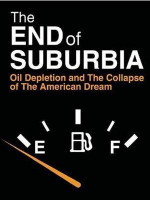The End of Suburbia: Oil Depletion and the Collapse of the American Dream Filming Locations

Where was The End of Suburbia: Oil Depletion and the Collapse of the American Dream filmed? The End of Suburbia: Oil Depletion and the Collapse of the American Dream was filmed in 4 locations across France, United States and Canada in the following places:
The End of Suburbia: Oil Depletion and the Collapse of the American Dream Filming Locations
Paris, France's capital, is a major European city and a global center for art, fashion, gastronomy and culture. Its 19th-century cityscape is crisscrossed by wide boulevards and the River Seine. Beyond such landmarks as the Eiffel Tower and the 12th-century, Gothic Notre-Dame cathedral, the city is known for its cafe culture and designer boutiques along the Rue du Faubourg Saint-Honoré.
San Francisco, officially the City and County of San Francisco, is a commercial, financial, and cultural center in Northern California. With a population of 808,437 residents as of 2022, San Francisco is the fourth most populous city in the U.S. state of California behind Los Angeles, San Diego, and San Jose.
Saratoga Springs is a city in New York State. A hub for thoroughbred horse racing, it’s home to the Saratoga Race Course. The National Museum of Racing and Hall of Fame displays horse paintings and trophies. Saratoga Spa State Park includes mineral baths, a pool complex and the Saratoga Performing Arts Center, a landmark concert venue. Nearby, the Saratoga Automobile Museum exhibits vintage models and race cars.
Toronto, the capital of the province of Ontario, is a major Canadian city along Lake Ontario’s northwestern shore. It's a dynamic metropolis with a core of soaring skyscrapers, all dwarfed by the iconic, free-standing CN Tower. Toronto also has many green spaces, from the orderly oval of Queen’s Park to 400-acre High Park and its trails, sports facilities and zoo.
The End of Suburbia: Oil Depletion and the Collapse of the American Dream (2004)
The modern suburbs have ultimately become an unsustainable way of living. They were originally developed in an era of cheap oil, when the automobile became the center of the way people lived and an era when people wanted to escape the inner city to a more pastoral or rural way of life. However the suburbs quickly evolved into a merely a place to live that had neither the benefits of rural or urban life, and where one was reliant on an automobile both to travel elsewhere and even travel within the neighborhood. The suburbs are not only dependent upon cheap energy, but also reliable energy. The reliability of energy is becoming less so as demonstrated by the multi-day blackout of the North American Eastern Seaboard starting on August 14, 2003. Part of the problem of getting out of the suburban mentality is that a generation has grown up believing it to be a normal way of life, and a life of entitlement, which they will not give up without a fight. But many developers and planners and some of the general public understand the want and need to make the way the collective we live in a more walkable and humanistic manner.
